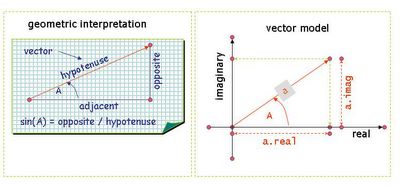Geometric signal interpretation of complex numbers

In revising the slides and notes for our class Introuction to DSP, I decided to add some explanation of complex numbers and how they relate to the real world. This is important because we actually develop DSP math using complex numbers, although most often we explain it (informally) without recognizing this.
Using complex numbers is useful because the math works well, but is often difficult for people to understand in practical terms - that is, what does the complex number represent?
In fact, though, many signals are easier to deal with if we think of them as being ‘2-dimensional’ vectors. A vector has both length and direction (or, in an x/y coordinate system, two components - x and y).
For example think of a sine function: at first sight this seems to be a classic case of a 1- dimensional signal - it has just one varying value (the sine). But a sine value is in fact derived from trigonometry, based on the ratio of the lengths of the sides of a right-angled triangle - the ‘opposite’ divided by the ‘hypotenuse’. So in some ways a sine is in fact better represented not just as some rather abstract number but as a triangle with an angle and a hypotenuse.
This leads us to the idea of treating the hypotenuse as a vector with length and direction (phase angle). A vector can be defined by its length and angle, or by specifying two (Cartesian, or ‘x, y’) components at right angles. But it would be nice to have just one ‘number’ to represent the vector, instead of always having to deal with the x and y components separately. Complex numbers give us a way to define such numbers.
Complex numbers have two components, that correspond to the ‘x’ and ‘y’ components. These are called the ‘real’ and the ‘imaginary’ components. A complex number is defined as a single entity (or ‘number’) but that is calculated as the sum of its real and imaginary parts:
a = a.real + j * a.imag
where ‘j’ is ‘the square root of -1'.
Before we get agitated about a square root of a negative number - because we were taught at school that any number squared gives a positive - let’s remember that lots of things we were taught are not in fact so: your school teacher was wrong, and you can have a negative square. Anyway, we are doing engineering so we will just use a property of j, leaving the philosophy to the mathematicians. j has just one property: when squared, it is equal to -1. That’s it. Nothing else. It makes the math work in a useful way - as we shall see.This is simpler in the sense that we can now write our arithmetic (or computer code) as things like: c = a + b instead of writing out all the manipulations for the components separately.
Comments
Post a Comment